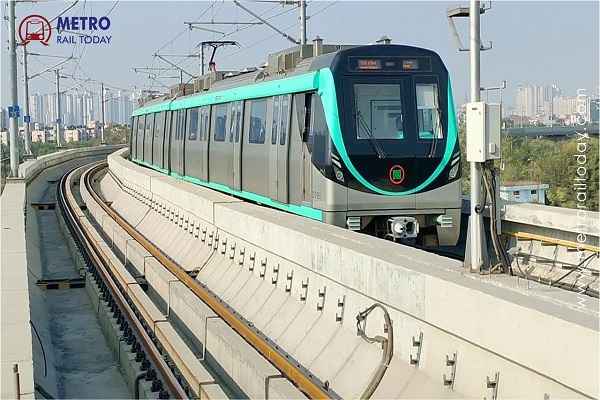 Ayesa India wins Design Consultancy Contract for Noida Metro Aqua Line Extension
Ayesa India wins Design Consultancy Contract for Noida Metro Aqua Line Extension Vossloh Cogifer bags Track Infrastructure Contract for Delhi Metro Phase 4 Corridors
Vossloh Cogifer bags Track Infrastructure Contract for Delhi Metro Phase 4 Corridors Railway finalised revised alignment for ₹16,000-crore Pune–Nashik Semi High-Speed Rail Corridor
Railway finalised revised alignment for ₹16,000-crore Pune–Nashik Semi High-Speed Rail Corridor India’s First High-Speed, Signalling-Integrated CMV launched for Namo Bharat RRTS Corridor
India’s First High-Speed, Signalling-Integrated CMV launched for Namo Bharat RRTS Corridor TuTr Hyperloop secures First-Ever Order from Deendayal Port Authority
TuTr Hyperloop secures First-Ever Order from Deendayal Port Authority BEML bags ₹157 Crore Order from Loram Rail for Switch Rail Grinding Machines
BEML bags ₹157 Crore Order from Loram Rail for Switch Rail Grinding Machines MxV Rail and KRRI forge Global Research Alliance to accelerate Next-Generation Rail Technologies
MxV Rail and KRRI forge Global Research Alliance to accelerate Next-Generation Rail Technologies Uttarakhand seeks Pre-Feasibility Study for Meerut-Haridwar-Rishikesh RRTS Corridor
Uttarakhand seeks Pre-Feasibility Study for Meerut-Haridwar-Rishikesh RRTS Corridor RIFTEK achieves major milestones in partnership with Indian Metro Rail Systems
RIFTEK achieves major milestones in partnership with Indian Metro Rail Systems Egypt all set to launch Alexandria Metro Phase 1 by 2026
Egypt all set to launch Alexandria Metro Phase 1 by 2026
Track laying work begins in Surat for Mumbai-Ahmedabad High Speed Rail Project

New Delhi, India (Metro Rail Today): In a significant stride towards high-speed rail connectivity in India, the construction of the first reinforced concrete (RC) track bed for the Mumbai-Ahmedabad bullet train project has commenced in Surat. Union Railway Minister Ashwini Vaishnaw made the announcement, marking a crucial milestone in the ambitious project.
The track system employed for the Mumbai-Ahmedabad bullet train is none other than the renowned Japanese Shinkansen bullet train technology. Notably, this project marks the inaugural use of the J-slab ballastless track system in India, according to the Ministry of Railways.
Contracts for the track works covering the entire Gujarat section of the project have already been awarded, and the procurement of materials for track works is currently in an advanced stage. A substantial quantity of JIS (Japanese Industrial Standards) rails, totaling over 14,000 metric tonnes, and 50 moulds for casting track slabs have been received from Japan.
The bullet train track is supported by RC anchors, specifically designed for high-speed travel at 320 kilometers per hour (kmph). These anchors are strategically placed at approximately five-meter intervals to prevent any longitudinal and lateral restraints on the track slab. The RC anchor measures 520 mm in diameter and 260 mm in height, ensuring the desired alignment for train operation at 320 kmph, as stated by Spokesperson at NHSRCL (National High-Speed Rail Corporation Limited).
The track system comprises pre-cast track slabs, onto which fastening devices and rails are affixed. These slabs rest on the RC track bed, with a thickness of approximately 300 mm, constructed on-site for individual 'Up' and 'Down' track lines on a viaduct top. The RC track bed boasts a width of 2,420 mm.
Dedicated factories have been established for the manufacture of track slabs, equipped with advanced technologies to ensure precision in High-Speed Rail track construction.
The track work will involve the deployment of specialized construction machinery, including the rail feeder car, slab laying car, and cement asphalt mortar (CAM) laying car.
Extensive training and certification programs for Indian contractors' personnel are being organized in collaboration with the Japan Railway Technical Services (JARTS) to ensure the proper execution of track laying.
The Mumbai-Ahmedabad High Speed Bullet Train project is slated to become operational by August 2026, revolutionizing travel between the two major cities. With a peak speed of 320 kmph, the 508-kilometer journey, which currently takes eight to nine hours, will be completed in approximately three hours.
This project represents a significant leap forward in India's high-speed rail ambitions, promising faster, more efficient, and modern rail travel for millions of commuters and travelers.






